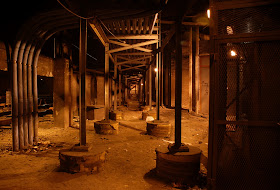
Grand Central Terminal is one of New York City's best known landmarks. Opened in 1913, this monumental structure has over 500,000 visitors a day. However, few of the millions who pass through Grand Central each year ever glimpse the mechanisms which control its complex system. This is "the largest train station in the world by number of platforms," according to Wikipedia, with with 67 train tracks spread out over 48 acres. All of this is run by a small army of traffic-controllers, substation engineers and track workers.
These workers operate in Grand Central's off-limits areas, in spaces accessible only through a network of private elevators, unmarked floors, secret staircases, and locked doors. These hidden spaces start with Grand Central's highest point, a small clock room containing the world's largest example of Tiffany glass. This luminous 13-foot-wide clock faces south down Park Avenue. It is accessed via a ladder in a closet behind an unmarked door. Just outside that door, construction has begun on a spacious new traffic-control center and situation room. Grand Central's current traffic-control center is a relatively cramped space, "home to roughly two dozen controllers who watch every move and hear every sound along the routes serving Grand Central," according to the NY Times.
Far below the traffic-control center, Grand Central's tracks spread out under the streets of midtown Manhattan. They are laced with wooden footpaths, dirt passageways and concrete bunkers. One track spur houses an abandoned platform and elevator which were reportedly used by President Franklin D. Roosevelt, according to Abandoned Stations. Some claim FDR also used the abandoned train car nearby. The power for this subterranean world comes from a substation hidden in a basement beneath Grand Central's main hall. Accessible via an unmarked freight elevator, basement M42 houses antiquated rotary converters next to modern equipment. In the breakroom, a handwritten sign reads "we have rats down here again." This is the lowest point in Grand Central.
---
Note: These photographs were taken while filming a documentary about my photography for "New York Wave" - a television show on NHK (the Japan Broadcasting Corporation) that profiles "young people in their 20's to 30's" in New York who are "a driving force in creating a bold idea." My episode aired from May through July, 2010.
























incredible.
ReplyDeleteboth breath taking and disturbing (not a rat fan)
ReplyDeleteAmazing!
ReplyDeleteWow. Cool photos. When I was in high school in the 70's - back when NYC had virtually no fences or locked doors, a classmate of mine (who ultimately went into urban planning) took me up to walk in between the double-paned glass windows of Grand Central. No doubt the door we went thru is now locked, so we appreciate others who can go "behind the scenes" and share it with us.
ReplyDeleteI truly enjoy your work...Thank you so much for sharing...
ReplyDeleteStunning photography! I love the behind the scenes stuff.
ReplyDeleteThe clock room pictures are wondrous. Thank you so much.
ReplyDeleteMy favorite book, Mark Helprin's "Winter's Tale," features several scenes that take place up above the ceiling of Grand Central, and since the first time I read that I have been imagining images like those.
Nathan,
ReplyDeleteGreat post, amazing photos.I've always been fascinated by the vast administrative world that exists behind, under and around large public spaces. It must be such a strange feeling to go back and forth between the two . . .
I just finished rereading 'The Mole People', about the homeless living below the surface in 80's NY. A lot of it seems fanciful now, but the writer writes of meeting a homeless colony living on an abandoned track line six or seven stories below the station. A lot of her claim has been disproved since (though it says a lot about early 90's NY that it seemed credible when I first read it in '93), but I wonder if there were ever homeless colonies of any kind living below the station, if there wasn't just a bit of truth to the writer's account.
T.